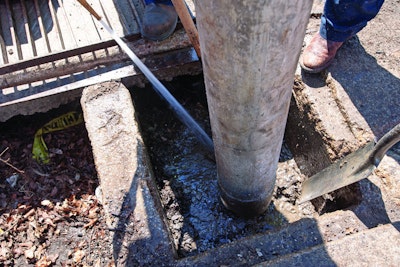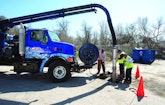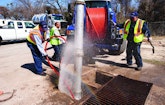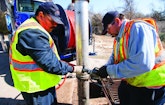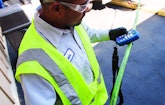
Interested in Inspection?
Get Inspection articles, news and videos right in your inbox! Sign up now.
Inspection + Get AlertsSince she first began working at Roto-Rooter of Fort Worth in 1987, Kim Miller knew she wanted to eventually own her own franchise, so when her father and company owner Bob Davis decided to retire in 2008, she embraced the opportunity to carry on the family tradition.
“I was extremely excited about the business part of the operation,” Miller says. “I enjoyed the accounting, being involved with advertising and marketing, and that Roto-Rooter is family-oriented. Working for my dad allowed me to see every aspect of that side of affairs.”
While Miller has no hands-on (or in the field) experience during her tenure with the company, she has confidence in her team, including Operations Manager Tim Ottis, Plumbing Manager Ray Freese (her son-in-law), and Safety Superintendent Rusty Eaton. While weathering the downturn in the economy, Miller has seen industrial/municipal work increase slightly to 53 percent of the business, with the balance in residential.
In 2011, the company put a focus on upgrading equipment across the board with a planned expenditure of up to $3.2 million, and they are generating a gross revenue of $3.8 million.
The comeback
Along with a stagnant economy in 2009, some municipalities had purchased their own pipe maintenance equipment, and there was a decided drop in industrial work for the company as clients opted to drop annual maintenance contracts. Miller’s team went to work securing more of that important business with major industrial and commercial entities as well as the smaller towns and cities in need of pipeline inspection, maintenance and repair. She credits her team, including service technicians out on the road, with putting the word out. The company’s strong reputation aided in the recovery.
Ottis came to the company in 2010 with 22 years experience with Roto-Rooter. Within a short time, Miller tabbed him to head up operations, with the goal of putting those larger pieces of underused equipment to work.
“We had a combination truck with an 1,800-gallon debris tank and two 1,000-gallon water tanks, and we were not using that,” Ottis says. “We began submitting bids for larger projects that we had not pursued for some years, and focusing on those contracts we did have. We also were fortunate to find some good hires and we began preaching to our guys to get on board with our vision for growth.”
After winning the bid on a large industrial project, Ottis admits they were initially a bit overwhelmed, but within a few weeks, they had settled into the groove and were performing to expectations.
In addition to basic services, the company provides maintenance on storm drains, lift stations, manhole to manhole (video inspection, cleaning and lining where possible), confined-space entry and pipe bursting.
On top of the game
“Typically the problems we find in pipe maintenance are age-related,” Ottis says. “With the clay pipe, there is heavy root penetration. A lot of buildup with dirt and debris in storm drains. We see old concrete pipe and SDR 35. Some municipalities don’t keep up with maintenance. They don’t have the equipment to do it on their own, and they are calling us in because we are able to take care of the problems.”
The company routinely deals with everything from 4-inch to larger 24- to 36-inch concrete pipe. Soil is typically clay, which tends to stick to everything and cause problems. They also encounter a lot of rock, so repairs involve conventional excavation after using hydroexcavation to locate other nearby underground lines. In tight places, a tunneling crew will use chipping hammers and jack hammers to break up the hard ground.
Tools of the trade
Meeting high demands calls for top-of-the-line equipment. Jetters and camera equipment play a starring role in the overall script for this Roto-Rooter, with four to five calls for a jetter service per day.
Crews use two Mongoose model 184 Jetters by Sewer Equipment Co. of America. The units are powered by CAT diesel engines and produce 4,000 psi/18 gpm. Both machines feature wireless remote systems with water on/off, throttle up/down, and reel in/out functions. For larger jobs, there is also a 1999 O’Brien (Hi-Vac Corporation) jetter truck with a 600-gallon water tank, 2,500 psi/50 gpm, for 10- to 18-inch sewer and storm drains. They prefer nozzles from Enz USA.
“We might want to use a larger skid-type nozzle where it will push the debris as it is propelled forward. Another nozzle will be used when the debris is on the bottom,” Ottis says. “Sometimes the buildup will be on the side walls of the pipe. We will have five to six different heads. The technicians need to determine the problem and the proper nozzle, and this will make life easier for the tech and the customer. Most often our senior technicians will be operating this type of equipment.”
The company recently added a 2012 Western Star 4800SD vacuum truck with a 4,200-gallon stainless steel, two-section vac tank, equipped with front lift and full rear-opening door. It has a 1600 cfm Robuschi TRB-DV85 blower package, and the jetter system is a CAT 660 hydraulic drive (3,000 psi/10 gpm) purchased through Tank Technologies & Supply Co.
Ottis and Miller confer regularly about the direction of the company, and the requisite equipment to bring on board. With large combination trucks, Ottis says the most important features are the size of the tank, the washdown capabilities, jetting capabilities and the size of the engine.
“Horsepower alone makes a big difference,” he says.
Inspection equipment includes a Rovver 5.0 Pipeline Video Inspection System by Envirosight, Rovver 900 fully steerable crawler with six wheels, and pan-and-tilt color video camera with remote focus and motorized cable reel. All of this is contained in an Envirosight tandem axle mobile trailer purchased through Green Equipment in Fort Worth. They also have an assortment of camera equipment from Hathorn Corporation, including four Magnum DVR control boxes, and several SeeSnake camera systems and NaviTrack Scout locators from RIDGID.
The broad array of camera equipment enables the company to deal with just about any type inspection, including smaller lines. Ottis says that they want to be able to offer the customer every option during an inspection.
While they typically subcontract lining work, they handle pipe bursting themselves and rely on the C20 and C25 systems from TRIC Tools, Inc.
New customers
Having the right equipment may be essential, but Ottis says their biggest challenge with industrial and commercial work is getting a foot in the door initially. Often a call will come from an industrial customer, an apartment complex or a municipality that may use another contractor who isn’t available for an emergency situation. Securing these customers can lead to regular maintenance contracts.
Ottis and Miller both had praise for their technicians, and their policy is to have one or two technicians assigned to a major client when possible so a relationship can be built.
“This way the technician knows the customer and the property, and the customer knows the technician,” Ottis says.
The right solutions
While pipe bursting is primarily used for their residential business, when a situation requires relining, they will bring in a subcontractor, and they have had some successful projects in this regard.
“One good example was a lining job for a food processing company that had built over an original storm sewer drain. Every time it rained, that particular line had enough cracks and breaks in the bottom that the rainwater would surface in the middle of the plant, which had to be kept very clean. We did a 24-inch liner on a 200-foot line. We brought in a contractor from out of state and we worked closely together. That line was 12 feet deep and ran under the building and made a hard right turn at one point before discharging into a field. The project went without a hitch,” he says.
Taking ownership
Technicians take responsibility for equipment and make sure it is handled properly, cleaned and returned into inventory and ready for the next area of service.
“They do take ownership,” he says. “When they take equipment out, they make sure nothing is missing and all is working. They do a walk-around before taking off – make sure all blinkers and tail lights are up and running, hoses are in good shape, that all nozzles are in place. And we have sign-in sheets where they log in and out when they take a particular piece of equipment.
“This is how they make their living,” Ottis says. “If something is missing or not properly cared for, it affects everyone. It is like a chain reaction. It has to be in an operation like ours.”
There is followup with a telephone call on every service rendered, with office staff checking to be sure every customer is satisfied with the job performance. Any issues are always dealt with promptly.
The company operates on a 6-acre site with a 4,000-square-foot service and warehouse building and a 5,000-square-foot office structure. Technicians all take their service vans home to assist in covering their 200-mile-radius service area, and two or three will be assigned night or weekend duty, as the business is a 24/7 operation.
Their staff includes two Master Plumbers (Ottis and Ray Freese), plus seven journeymen, in addition to tradesmen, apprentices, other field staff, a combination unit and pump truck specialist, as well as their office personnel.
Reese and Ottis conduct weekly meetings with technicians, and Miller is always available and frequently sits in. Safety meetings are conducted monthly by Rusty Eaton and there is additional training on confined-space entry as well as shoring and trenching.
Miller says they are always looking into other services they could offer to help grow the company, but they also want to streamline what they now provide. “These are things we discuss a lot. We are anxious to make those kinds of decisions as we find our path to success with our vision and strategy.”
